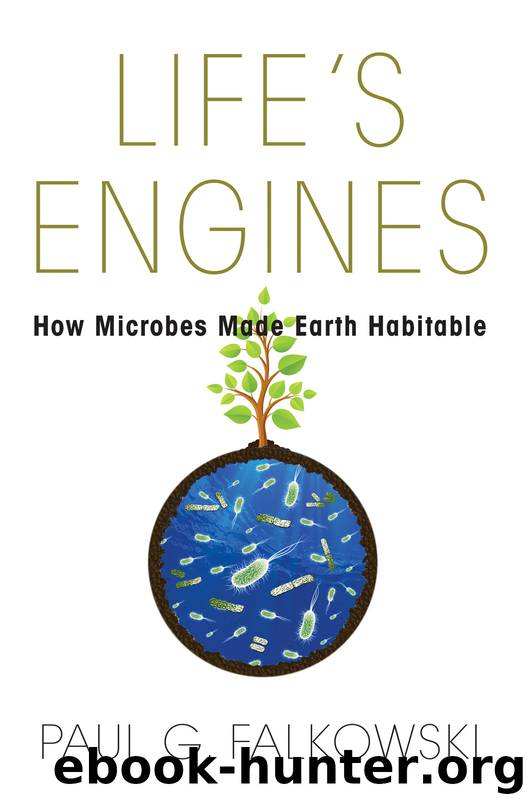Life's Engines by Falkowski Paul G.;

Author:Falkowski, Paul G.;
Language: eng
Format: epub, mobi
Publisher: Princeton University Press
Published: 2015-03-06T16:00:00+00:00
FIGURE 25. A micrograph of a marine virus particle. The genetic information of the virus is contained in the head, while the stalk is used to attach to the host cell (e.g., a bacterium). The virus injects its genetic material into the host and uses its machinery to replicate many more viruses. Note that this particle is about one-tenth the size of the smallest cyanobacteria (Fig. 17B). (Courtesy of Jenn Brum and Matthew Sullivan)
Do viruses transfer genes? In principle, yes, but mostly only over short evolutionary distances. Viruses attach to and insert their genetic material into cells, but they tend to have fairly strict requirements for their hosts. They recognize their hosts by specific proteins on the surface of the host’s cell, and when they find a suitable host, they can attach to and then transfer their DNA or RNA into the host’s cells. The genetic material becomes incorporated into the host and hijacks the host’s nanomachines for making proteins and nucleic acids to create new viruses. In some cases, the virus simply is reproduced in the host cell forever—it becomes part of the genome of the host cell. In humans, those types of viruses can be extremely bad news. Two examples of these nonlytic (because don’t lyse the cell) viruses are HIV and hepatitis C. When they infect a human, they are almost impossible to remove from the genome.
In other cases, however, the newly inserted genetic information allows new viruses to grow inside the host cell until they reach a certain population threshold—then the host cell bursts, releasing the new viruses to the environment. This invasion-of-the-body-snatcher scenario is pretty common in the microbial world—and leads to the death of a lot of microbes. These lytic (because they lyse the cell) viruses are also found to infect humans—and, perhaps surprisingly, they are less lethal than the viruses that do not kill cells outright. These types of viruses include those that cause a common cold. Lysis doesn’t directly lead to transfer of genes to new hosts, but it does allow the host cell’s genetic information to spill out into the environment, where it can be taken up by microbes searching in the genetic wastebasket for leftovers.
The third type of process is called conjugation, in which microbes exchange DNA by attaching to each other and forming a bridge between the two cells. This process occurs between closely related microbes, but it not clear how or why it would transfer genes across organisms that are distantly related.
Regardless of the mechanism, horizontal gene transfer makes it very difficult to determine the ancestry of the organisms in deep time, but even more important, it makes the concept of a species in microbes difficult to define, if not irrelevant.
Imagine that you wanted to find out your ancestry. You find where your parents were born, their parents, and so on—but imagine that some thirty or fifty generations ago, genes that digest carbohydrates in seaweed were inserted into the microbial community in the guts of your family because your ancestors ate a lot of sushi.
Download
This site does not store any files on its server. We only index and link to content provided by other sites. Please contact the content providers to delete copyright contents if any and email us, we'll remove relevant links or contents immediately.
| Cell Biology | Developmental Biology |
| Entomology | Marine Biology |
| Microbiology | Molecular Biology |
| Biostatistics |
Sapiens: A Brief History of Humankind by Yuval Noah Harari(13986)
The Tidewater Tales by John Barth(12391)
Mastermind: How to Think Like Sherlock Holmes by Maria Konnikova(6936)
Do No Harm Stories of Life, Death and Brain Surgery by Henry Marsh(6683)
The Thirst by Nesbo Jo(6435)
Why We Sleep: Unlocking the Power of Sleep and Dreams by Matthew Walker(6352)
Life 3.0: Being Human in the Age of Artificial Intelligence by Tegmark Max(5184)
Sapiens by Yuval Noah Harari(5121)
The Longevity Diet by Valter Longo(4856)
The Body: A Guide for Occupants by Bill Bryson(4580)
The Rules Do Not Apply by Ariel Levy(4523)
The Immortal Life of Henrietta Lacks by Rebecca Skloot(4253)
Why We Sleep by Matthew Walker(4190)
Animal Frequency by Melissa Alvarez(4148)
Yoga Anatomy by Kaminoff Leslie(4100)
The Hacking of the American Mind by Robert H. Lustig(4082)
All Creatures Great and Small by James Herriot(3984)
Barron's AP Biology by Goldberg M.S. Deborah T(3943)
Double Down (Diary of a Wimpy Kid Book 11) by Jeff Kinney(3924)
